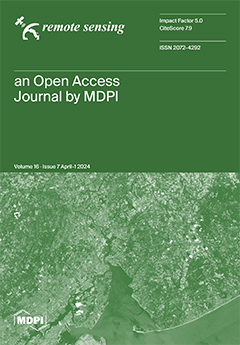Combustion power plants emit carbon dioxide (CO
2), which is a major contributor to climate change. Direct emissions measurement is cost-prohibitive globally, while reporting varies in detail, latency, and granularity. To fill this gap and greatly increase the number of power plants
[...] Read more.
Combustion power plants emit carbon dioxide (CO
2), which is a major contributor to climate change. Direct emissions measurement is cost-prohibitive globally, while reporting varies in detail, latency, and granularity. To fill this gap and greatly increase the number of power plants worldwide with independent emissions monitoring, we developed and applied machine learning (ML) models using power plant water vapor plumes as proxy signals to estimate electric power generation and CO
2 emissions using Landsat 8, Sentinel-2, and PlanetScope imagery. Our ML models estimated power plant activity on each image snapshot, then an aggregation model predicted plant utilization over a 30-day period. Lastly, emission factors specific to region, fuel, and plant technology were used to convert the estimated electricity generation into CO
2 emissions. Models were trained with reported hourly electricity generation data in the US, Europe, and Australia and were validated with additional generation and emissions data from the US, Europe, Australia, Türkiye, and India. All results with sufficiently large sample sizes indicate that our models outperformed the baseline approaches. In validating our model results against available generation and emissions reported data, we calculated the root mean square error as 1.75 TWh (236 plants across 17 countries over 4 years) and 2.18 Mt CO
2 (207 plants across 17 countries over 4 years), respectively. Ultimately, we applied our ML method to plants that constitute 32% of global power plant CO
2 emissions, as estimated by Climate TRACE, averaged over the period 2015–2022. This dataset is the most comprehensive independent and free-of-cost global power plant point-source emissions monitoring system currently known to the authors and is made freely available to the public to support global emissions reduction.
Full article





